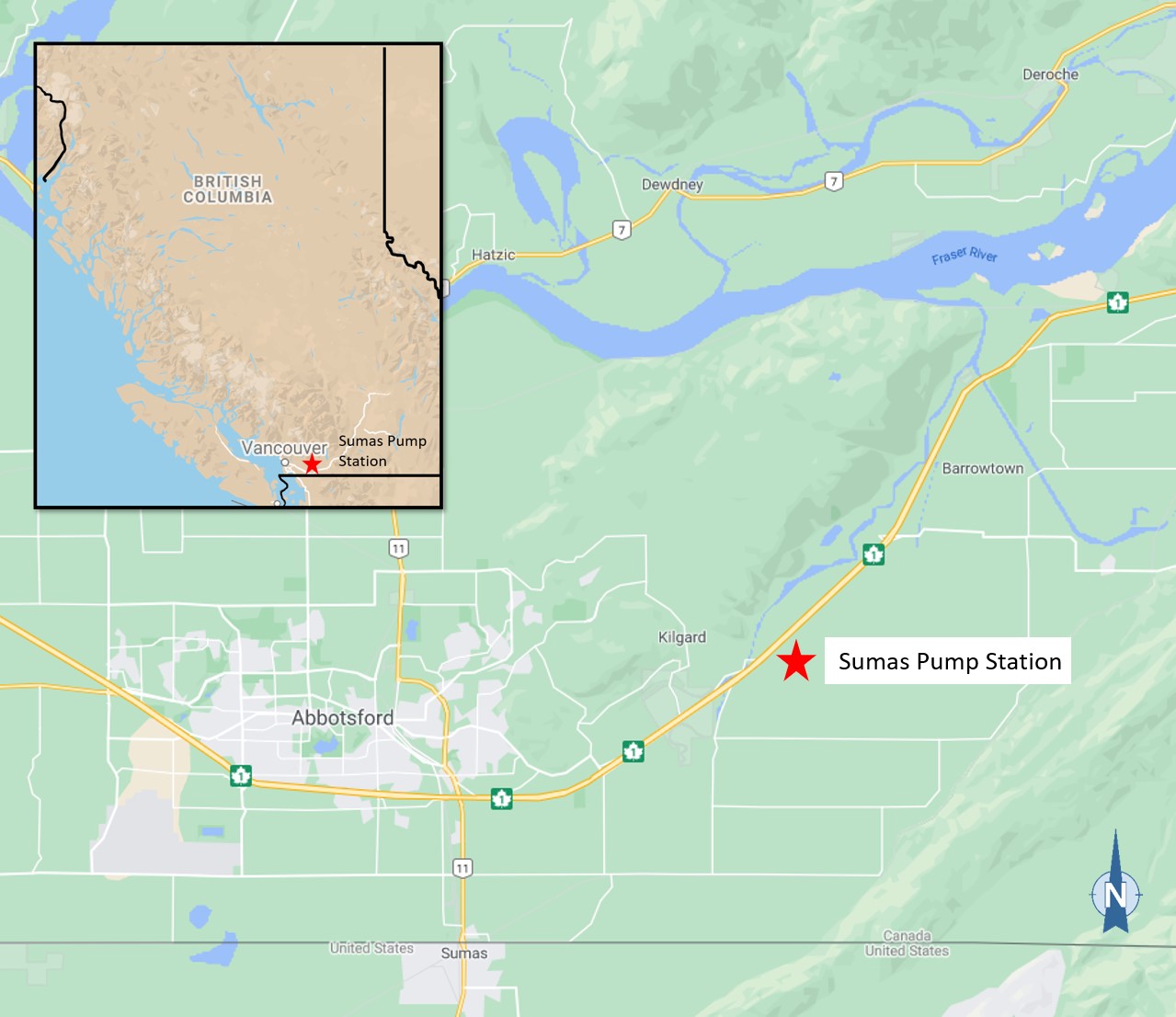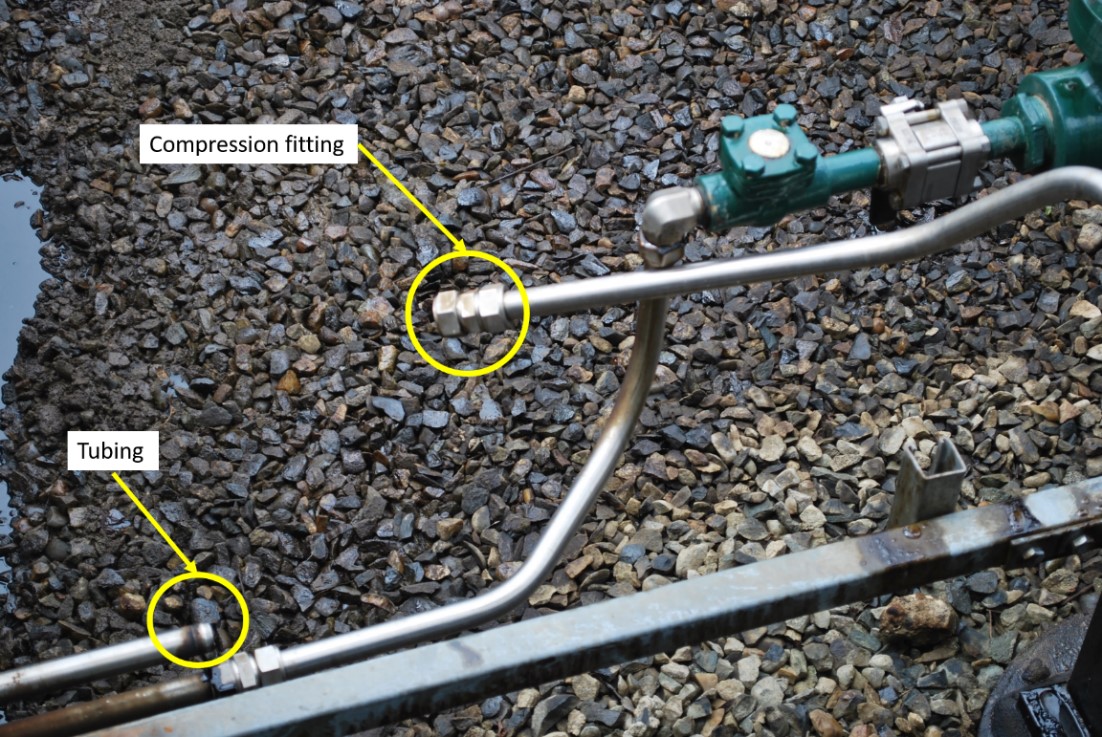Release of crude oil incident
Trans Mountain Pipeline ULC
Sumas Pump Station
Abbotsford, British Columbia
The Transportation Safety Board of Canada (TSB) investigated this occurrence for the purpose of advancing transportation safety. It is not the function of the Board to assign fault or determine civil or criminal liability. This report is not created for use in the context of legal, disciplinary or other proceedings. See Ownership and use of content. Masculine pronouns and position titles may be used to signify all genders to comply with the Canadian Transportation Accident Investigation and Safety Board Act (S.C. 1989, c. 3).
The occurrence
On at 2232,Footnote 1 a release of crude oil occurred from an above-ground section of 1-inch tubing within Trans Mountain Pipeline ULC's (Trans Mountain) Sumas Pump Station in Abbotsford, British Columbia (Figure 1). During initial site assessment, 2 nearby residents were asked to shelter in place by emergency response personnel. There were no injuries, and no evacuation was required.
Trans Mountain’s Sumas Pump Station
The Sumas Pump Station is located in Abbotsford, British Columbia. It services the Trans Mountain pipeline, which is regulated by the Canada Energy Regulator. The Trans Mountain pipeline transports petroleum crude oil and refined petroleum products from Edmonton, Alberta, to refineries and terminals in British Columbia and the state of Washington, United States.
The property is divided in 2: a north section, which contains the pump station as well as the associated containment and monitoring systems, and a south section, which is leased by a third party for agricultural purposes.
The Sumas Pump Station is monitored and controlled 24 hours a day by Trans Mountain’s Control Centre Operations (CCO) in Edmonton.
At the time of the occurrence, the pump station was operating within prescribed limits. There were no personnel on site.
Site examination
The crude oil released from a 1-inch compression fitting that had separated from tubing on a section of above-ground piping adjacent to the building that houses the equation-of-state (EOS)Footnote 2 system (Figure 2).Footnote 3 The failed compression fitting was used to join tubing from the discharge mainline to the EOS system.
Approximately 150 to 190 m3 of crude oil was released.Footnote 4
From the point of release, the oil had followed a path into the pump station’s surface drainage system, through an oil-water separator, and into a culvert that discharges surface water into the south section of the property (Figure 3). As a result, 7 m3 of the released oil had migrated to the agricultural field in the south section.
During site cleanup, approximately 143 m3 of the product was recovered, including about 6.6 m3 from the south section.
Notification of the occurrence and Trans Mountain’s response to the occurrence
At 2240, the CCO received a supervisory control and data acquisition (SCADA) alarm indicating that hydrocarbon had been detected in the building housing the EOS system at the Sumas Pump Station.
At 2241, the control centre operator contacted the on-call field technician to investigate the cause of the alarm.
At 2256, the SCADA system detected combustible gas in the pump building and raised a high-severity alarm, which triggered an automatic emergency shutdown (ESD) of the Sumas Pump Station.Footnote 5
At 2303, the control centre operator contacted the on-call field technician to provide them with an update on the situation, requested additional personnel to respond, and initiated a controlled shutdown of the Trans Mountain mainline.
At 2328, the controlled shutdown of the mainline was completed.
At 2338, the on-call field technician confirmed the release of crude oil at the Sumas Pump Station.
At 0332 on 13 June 2020, Trans Mountain personnel located and safely isolated the source of the release.Footnote 6
Failure analysis of the failed compression fitting
The following components recovered from the occurrence site were sent to an independent laboratory for detailed failure analysis:
- the failed compression fitting;
- the section of tubing on which the failed fitting was installed (the occurrence tube); and
- comparison tubes and fittings from the same tubing system.
The failed fitting was a 1-inch stainless steel double-ferrule mechanical grip compression fitting manufactured by Swagelok (part number SS-1610-6). This type of fitting consists of an outer nut, a front ferrule, a back ferrule, and a fitting body (Figure 4).
Installation consists of fully inserting a tube into the bottom of the fitting and turning the nut. As the nut turns, the double-ferrule design creates a seal between the fitting body and the tubing, while also compressing against the tubing to ensure that the fitting is tight. The manufacturer's installation instructions for this type of compression fitting specify a 1¼ turn on the nut after finger tightening.
In this occurrence, the tube had pulled free from the compression fitting. A preliminary analysis determined that the occurrence tube had marks of progressive sliding between the two ferrules, which suggested insufficient tightening of the compression fitting at the failure location.
As part of the laboratory analysis, to reproduce the degree of tightening found on the failed occurrence tube, sections of comparison tubes were tightened incrementally from ¼ to ¾ turn. It appeared that no more than 5/8 of a turn would lead to a similar degree of tightening as that found on the failed occurrence tube.
The laboratory analysis concluded that the compression fitting failed because of a loss of ferrule grip due to improper tightening during installation.
Installation of the occurrence compression fitting
The occurrence compression fitting was installed in 2015, when Trans Mountain replaced the station discharge flow meter, which required the EOS system tubing to be reconfigured.
Trans Mountain uses the manufacturer’s instructions for the installation of compression fittings.Footnote 7 As part of the installation process, Trans Mountain’s standards and procedures did not include an inspection of these individual fittings. However, in accordance with the requirements set out in Standard Z662-15Footnote 8 of the Canadian Standards Association, Trans Mountain subjected the assembly to a pressure test (with product) to ensure that the piping system was leak-tight. This test took place on 10 December 2015. No leaks were observed.
Release detection and isolation of the equation-of-state tubing system
On the day of the occurrence, the controls for the detection of hydrocarbons and combustible gas in the EOS system building worked as designed and triggered the necessary alarms in the SCADA system, which were acknowledged by the CCO.
When the combustible gas reached its lower explosive limit of 20% in the pump building, an ESD of the Sumas Pump Station was automatically initiated. In an ESD, the relevant valves are automatically set to allow the flow from the mainline to bypass the station and, once set, they are locked into position.Footnote 9
The ESD procedure isolated the EOS system building by closing the automatic valves at the inlet and outlet tubing of the building. However, the compression fitting that failed in this occurrence was in a section of above-ground tubing between the building and the station bypass line. The valves required to isolate this section of tubing were manual valves, and therefore were not part of the automatic shutdown sequencing (Figure 5). They remained open, allowing the product to continue to release from the failed compression fitting. To stop the release, the valves for that section of EOS system tubing had to be closed by hand, which Trans Mountain personnel did when it was safe to enter the site, approximately 5 hours after the CCO received the initial alarm.
Secondary containment at the pump station site
The Sumas Pump Station is designed with a system of site grading and drainage that allows surface water to flow into the south (agricultural) section of the property through a culvert. As part of this system, the surface water goes through an oil-water separator that serves 2 purposes:
- detect if hydrocarbons are present in the surface water and send alarm notifications if this happens; and
- trap the oil products before they are released into the agricultural field.
The presence of hydrocarbons in the oil-water separator is an indication that there is an oil release at the pump station. Upon receiving an alarm from the separator, operators must follow the procedures set out in the Sumas Pump Station Operating Manual, which include initiating emergency response protocols as required, stopping any ongoing release of water, and isolating or stopping the source of the oil leak.Footnote 10
In this occurrence, by the time the oil releasing from the EOS system reached the oil-water separator and triggered an alarm at 2342, the Sumas Pump Station was already in emergency shutdown. The oil, which was still flowing from the failure location, continued to accumulate in the separator until it could no longer be trapped effectively.Footnote 11
The separator is not equipped with an automated isolation system, nor does it have manual isolation valves. Therefore, once oil began flowing into the agricultural field, there was no means to stop it until operators could isolate the source of the release on the EOS system.
After the source of the release was isolated, Trans Mountain placed vacuum trucks at the oil-water separator and along the fence line separating the north and south sections of the property to prevent further product migration into the agricultural field by capturing the oil before it could reach it.
Site remediation
Site remediation of both the north and south sections of the property started on 13 June 2020, once the site was safe for access.
Soils affected by the released product were excavated to the extent practicable while considering geotechnical and facility integrity constraints. At locations where excavations extended to the groundwater table, vacuum trucks were used to recover free product (as an oil-water mixture) from the groundwater.
For remaining contaminants that could not be physically removed from the site, a multi-year remediation plan has been developed. The most appropriate remediation methods will be selected and implemented based on the results of continued monitoring and testing of the soil and groundwater.
Safety action taken
Following the occurrence, the Canada Energy Regulator conducted emergency management and environmental protection field inspections and has monitored the progress of site remediation activities.
Trans Mountain has undertaken the following actions as a result of this occurrence:
- Develop a procedure to verify the integrity of the existing tubing systems.
- Develop an internal standard outlining the requirements for the construction and quality assurance of new tubing systems, as well as a procedure for the installation of tubing systems by Trans Mountain personnel.
- Add an automated isolation valve on the inlet of the EOS tubing system and a check valve on the outlet.
- Reconfigure the ESD logic to allow select automated valves to be actuated remotely after an ESD.
- Initiate a project, to be completed by summer 2021, to upgrade the Sumas Pump Station, including the installation of:
- containment and drainage features;
- a new oil-water separator, which will discharge to a new PVC culvert, manhole and collection basin system before ultimately discharging through a final isolation valve; and
- a lined containment area around the station’s above-ground piping.
Safety message
It is important for pipeline companies to establish standards and procedures that incorporate inspections to ensure that tubing systems are properly installed.
In the event of an unplanned product release, it is essential that station ESD and isolation systems be properly configured to minimize the quantity of the release. Furthermore, secondary containment systems, such as the oil-water separator in this occurrence, must have a means of isolation in order to prevent any off-site migration of the released product.
This report concludes the Transportation Safety Board of Canada’s investigation into this occurrence. The Board authorized the release of this report on . It was officially released on .




